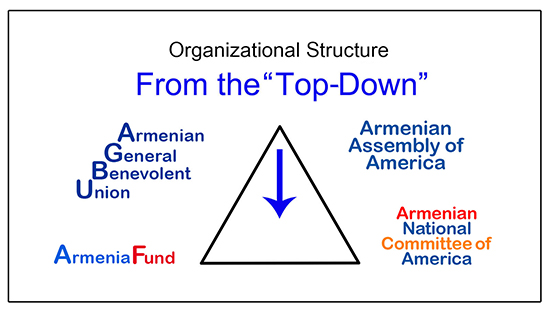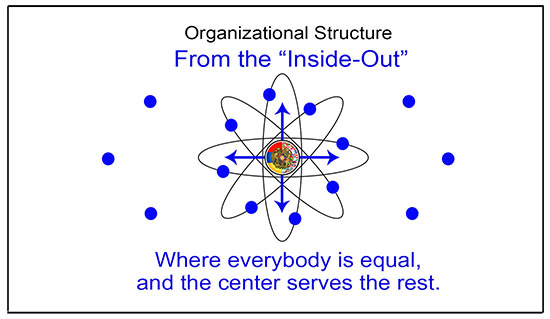Our Story - Part 1
PRELUDE: Overcoming Disunity to Preserve Armenia
The Armenian National Association (ANA) was born of war and necessity—politics, protest, and action. And now the very essence of Hayastan’s future depends upon its success.
The ANA is not the first attempt to unify the Spyurk, but it is a novel plan with a different structure from all the rest. The ANA represents a new day and a new way for the Armenian Diaspora.
Unlike the other important Armenian organizations that have preceded the ANA and paved the way, the ANA is not a centralized, top-down organization.

These older institutions in the Spyurk will always be corporate products of a pre-modern age with their DNA rooted in centralized, hierarchical systems controlled by a relatively few leaders at the top of their structural pyramids. Because of their high position within the corporate structure, these leaders are always under attack by other jealous and independent-minded Armenians. As a matter of mere survival, the leaders of these older “top-down” institutions are unencumbered with logistical concerns related to organizing and managing the participation of millions of ordinary members needed to unify the Spyurk.
This might explain why the AGBU, the ANCA, the ARF and others who have been enormously successful in the past have not been able to adapt to new social media and open-source technologies that are necessary to connect their organization to millions of new Haystansi Spyurk at the grassroots level who are currently not affiliated with any group outside of their family or the Church.
By contrast, the ANA is a decentralized membership organization with a centralized command and control center for operations that serves its members from the inside-out. Everyone participates equally within a multiplicity of local chapters that are completely independent and autonomous.
Utilizing this unique organizational structure that empowers millions of Armenians at the grassroots, the Spyurk can now become organized and focused on gaining the political power needed to preserve Armenia and Artsakh rather than wasting their time and energy on managing internal conflict.

Following the Pashinyan-led Velvet Revolution in 2018, and leading up to the Turkish invasion of Artsakh, dozens of planning groups were being formed around the world and used social media to unify the Armenian Spyurk like never before. It felt as if a common premonition was being carried in the soul of every Armenian: Our Homeland is in trouble. Something bad is coming. And the only way to protect her is to unify the Diaspora!
A true love of Armenia and Artsakh became the glue that brought everyone together. It was both sad and beautiful, all at the same time, and everyone felt it.
On the night of October 4, 2020, when 40,000 angry and grieving protesters closed down the city streets of Hollywood from the CNN building all the way to the 101 freeway, there was no ANCA, no Armenian Assembly, no Hanchuktutsyun, no AGBU, no Adam Schiff, no Ramgavar, no My Step, no evangelical Armenians, no Echmiadzin and no Antelias; no Biden, no Trump.
There was only Artsakh and Armenia.
Like most of the other organically grown unity groups that had been forming before the war, no IRS papers had been filed for the Armenian National Association (ANA), no official ANA board meetings had been called, and no written minutes had been recorded. Instead, it was just pure energy.
All of this was preceded by a nine-year period of relationship-building and pre-organizing conversation. This was followed by two years of intensive meetings—week after week, in Hollywood, Glendale, and across the San Fernando Valley—when a vibrant network of new Hayastanci Spyruk leaders began to emerge alongside the old Spyurk leaders.
First, Raffi and Vicken Sosikian, Megi Hakobjanyan, Jiro Khorozian, Ara Manoogian, Gurgen Mkrtchyan, Ando Torosyan, Thomas and Hrayr Rubenyan, Vahag Shushanyan, Saten Gharabetsyan and Harut Momdjian, then Nane Gevorgyan, Haig Malkhasyan, Marat and Edgar Hay, Nazeli and Vahe Hindoian, Maddie Dokholian, Petik Tangikyan, Samvel Karajian, Haik Sargsian, Mkhitar Mkrtchyan, Rose Zatikian, Ani Ghaplanyan, Gago Oganesyan, Alex Aslanyan, Gary Madatayan, Mher Bahgdasaryan, Krikor Mesrobian, Ara Boyadjian, Henry Kazarian, Armen Andoyan, Arthur Sahakyan, Anushavan Shakhnazaryan, Aram Tonoyan, Edward Kalaydjian, Armen Hagopjanian, Sarkis Kiramijyan, Vanik Potikyan, Tigran Marutyan, Arman Abajyan, Aram Asatryan, Vahe and Shahen Tarakchyan, Vram Martirosyan, Sevak and Hrach Aghavelyan, Eduard Osipov, Jack Kayajian, Margarita Khlghatyan, Kristina Kalajyan, Harut and Davit, Sargis Tadevosyan, Elena Semerdjian, Suzy Sukiasyan, Anush Muradyan, Jessica Gevorkyan, Sleepy and the Armenian Brigade, Steven Sparrow, Robert Torossyan, Fred Tatlyan, Vardan Amolikyan, Arpi Manukyan, Tigran Galstyan, Artur Hovhannisyan, Karen Khurshudyan, Hamlet Aroyan, Artak Sergoyan, Rose Casta, Mihran Hunanyan, Hayk Yeghiazazyan, Narek Marutyan, Karen Martirosyan, Tiran Antaplian, Ruben Stepanyan, Manvel Nazerian, Narek Saakian, Tadevose Saakyan, Abraham Adamyan, Levon Gazdzhyan, Kristine Kumuryan and the list keeps growing!
But, this did not just happen in a vacuum.
